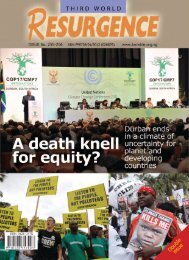Plantations, poverty and power - Critical Information Collective
Plantations, poverty and power - Critical Information Collective
Plantations, poverty and power - Critical Information Collective
You also want an ePaper? Increase the reach of your titles
YUMPU automatically turns print PDFs into web optimized ePapers that Google loves.
113<br />
The Food <strong>and</strong> Agriculture Organisation: Promoting the lie of “Planted Forests”<br />
Created in 1945, the United Nations Food <strong>and</strong> Agriculture Organisation has worked hard on behalf of the<br />
plantation industry to reinforce the myth that a plantation is a forest. In its 2005 Global Forest<br />
Assessment, for example, FAO concludes that the “rate of net loss” of forests is decreasing. It sounds<br />
good, until you realise that in its definition of forests, the FAO includes monoculture plantations, highly<br />
degraded forests <strong>and</strong> even clearcuts which are expected to regenerate.580<br />
FAO has played an important role in promoting the commercialisation of tropical forestry generally581,<br />
<strong>and</strong> the industry with which FAO’s forestry department has had the “longest <strong>and</strong> deepest involvement” is<br />
the pulp <strong>and</strong> paper industry.582 FAO has produced studies aiming to facilitate investment <strong>and</strong> production<br />
in the pulp <strong>and</strong> paper industry in a wide range of tropical countries.<br />
The Fifth World Forestry Congress, which took place in Seattle in 1960, discussed “the need for action to<br />
use forest tree improvement to strengthen afforestation <strong>and</strong> reforestation programs <strong>and</strong> to increase the<br />
yield of the world’s forests”. The Congress recommended that the FAO organise a technical conference,<br />
“to co-ordinate <strong>and</strong> promote the development of tree improvement techniques, the mass production of<br />
improved planting stock, <strong>and</strong> the incorporation of these techniques <strong>and</strong> plants into afforestation <strong>and</strong><br />
reforestation programs in a scientific <strong>and</strong> economic manner”. FAO subsequently organised a meeting,<br />
“The World Consultation on Forest Genetics <strong>and</strong> Tree Improvement,” which took place in Sweden, in<br />
August 1963.583<br />
“The regional timber trend studies published by FAO demonstrate the greatly increased dem<strong>and</strong> for forest<br />
products in tropical countries, as a result of rising st<strong>and</strong>ards of living <strong>and</strong> rapid increases in population,”<br />
noted the participants at the conference. They concluded that industrial tree plantations were needed to<br />
meet this dem<strong>and</strong>: “These trends, coupled with the generally low productivity of natural tropical forest<br />
st<strong>and</strong>s, are focusing increased attention on the need to establish plantations of high-yielding species –<br />
either to supplement or replace the natural st<strong>and</strong>s.”584<br />
The conference recommended that governments in the South develop “planned programs of forest<br />
genetics <strong>and</strong> tree improvement”.585 The conference commended the governments of Australia <strong>and</strong><br />
Mexico “for their help in collections of eucalypts <strong>and</strong> Mexican pines, <strong>and</strong> urges FAO to encourage <strong>and</strong><br />
support the extension of such action to satisfy critical needs.”586 The conference recommended that the<br />
FAO’s Forestry <strong>and</strong> Forest Products Division should set up an advisory <strong>and</strong> information unit “on the<br />
introduction of forest trees with actual or potential use as exotics”.587<br />
580 “FAO’s net loss in credibility over global forest resources assessment”, World Rainforest Movement Bulletin 100,<br />
November 2005. http://www.wrm.org.uy/bulletin/100/FAO.html<br />
581 George Marshall (1991) FAO <strong>and</strong> Tropical Forestry, The Ecologist, Vol. 21 No. 2, March/April 1991, page 66.<br />
582 “FAO: The First Forty Years”, Food <strong>and</strong> Agriculture Organisation, 1985, page 59.<br />
583 J.D. Matthews (1964) “General Introduction – FAO/IUFRO meeting on forest genetics", Unasylva, Vol. 18 (2-3),<br />
No. 73-74.<br />
584 “Proceedings of the World Consultation on Forest Genetics <strong>and</strong> Tree Improvement, FAO, 1964”, Unasylva, Vol. 18<br />
(2-3), No. 73-74.<br />
585 “Proceedings of the World Consultation on Forest Genetics <strong>and</strong> Tree Improvement, FAO, 1964”, Unasylva, Vol. 18<br />
(2-3), No. 73-74.<br />
586 “Proceedings of the World Consultation on Forest Genetics <strong>and</strong> Tree Improvement, FAO, 1964”, Unasylva, Vol. 18<br />
(2-3), No. 73-74.<br />
587 “Proceedings of the World Consultation on Forest Genetics <strong>and</strong> Tree Improvement, FAO, 1964”, Unasylva, Vol. 18















